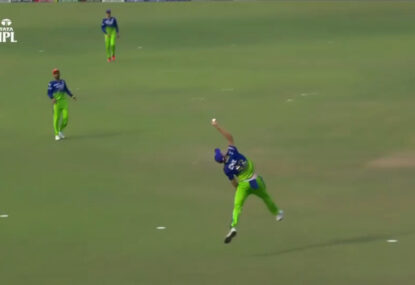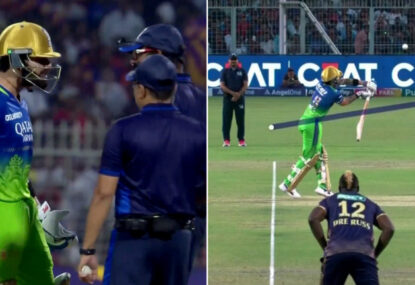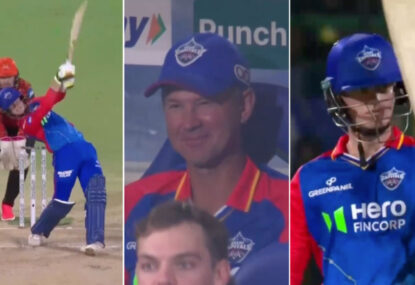The brilliance of Shane Warne was that apart from everything else, he was an extraordinary cricketer.
And there was a lot of “everything else” off the field but in a cricket career recognised as one of the five greatest in the 20th century, he was a truly once in a generation player.
That terms gets thrown around a lot but for Warne, it was as accurate as his vicious leg breaks.
Australia is in a state of shock as well as a state of mourning, along with the rest of the cricketing world, following the spin king’s death at the age of 52 in Thailand.
The tales are well told about how Warne lived a fast life off the field during his playing days and into his retirement but a suspected heart attack claiming his life just a day after wicketkeeping legend Rod Marsh’s death is the kind of tragedy that stops nations.
Warne in his playing days was simply mesmerising. The great Richie Benaud, a leg-spinning all-rounder who captained Australia, would light up in his own understated way whenever Warne was on the field.
Benaud had seen generations of players, all kinds of talented batters and bowlers, but he had never seen anyone like Warne and it made the revered commentator’s eyes twinkle like a schoolboy.
And no one has been able to do anything close to Warne’s on-field feats since.
Statistics will come and go, Muttiah Muralitharan took more Test wickets than Warne but the Australian had the magnetism to draw fans to the game and TVs by the millions.
Have you ever tried to bowl leg spin? It’s hard enough to flick your wrists the right way to get the ball up the other end of the pitch in the vague vicinity of the batter.
For Warne, it was natural. He had the strength in the forearms to make the ball fizz through the air. Batters would often talk about how they could hear it coming.
But not only that, he could turn those leg breaks a proverbial mile. There had been leg spinners before him and since who could make the ball turn sideways but none of them had anywhere near the control that Warne possessed.
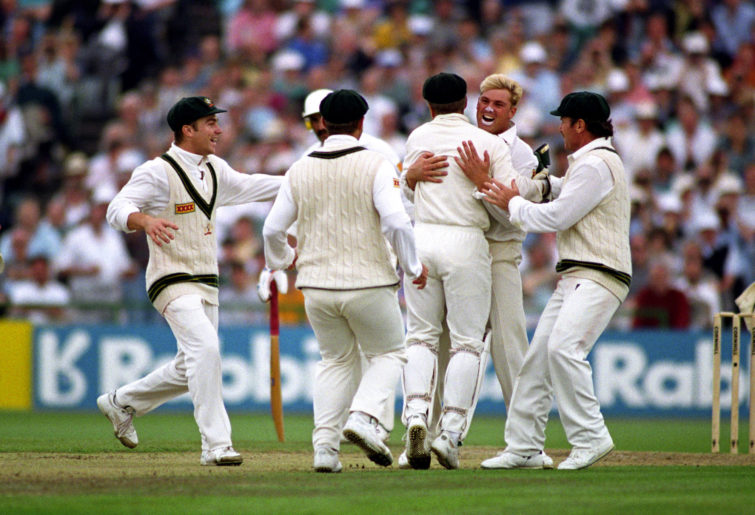
Shane Warne’s ‘Ball of the Century’ – arguably the greatest delivery bowled in Ashes cricket. (Photo by Rui Vieira/EMPICS via Getty Images)
And then there was the flipper. The most incisive trick in his bag which in his younger years made batters look foolish time and time again. They’d have a fear in their eyes knowing it was coming – you suspected they’d rather be facing the steepling bounce of Curtly Ambrose or the prodigious swing of Wasim Akram than have to front up to Warne sending down spinners at a much gentler pace all the while knowing there was a strong chance he would take both their wicket and their dignity.
Like Kobe Bryant’s death from a helicopter accident in 2020 shocked the United States and Diego Maradona’s demise later that year sent Argentina into national mourning, Warne’s untimely passing has that surreal feeling to Australians today.
Most of the country is waking up to the news having that split-second feeling of “no, that can’t be true”. You hope it’s some sort of prank, the kind of fake news you wish is true.

(Photo by Daniel Pockett/Getty Images)
Then you realise Warne is human after all. It is true.
It will affect people from all walks of life, not just cricket fans.
Of all people, Australian snooker player Neil Robertson was one of the first to speak publicly about how Warne’s death had affected him, saying he couldn’t concentrate as he lost to Judd Trump at the Welsh Open.
“I was hit by a truck with the news as I left the hotel,” Robertson told Eurosport following his 5-3 defeat in the quarter-finals. “A national hero, and idol of mine growing up, and I was fortunate enough to meet him. It’s just awful. All of Australia will be in mourning.
“He’s our national hero, with what he did for Australian cricket and cricket all over the world. It’s like when Diego Maradona died for Argentinians. It’s as bad as it gets and I just feel awful for his friends and family and cricket fans around the world.”
Warne’s impact was not just limited to his career. The numbers are immense but even they don’t do him justice. In 145 Tests he took 708 wickets at 25.41 and was a decent batter, amassing 3154 at 17.32, including his famous 99 against the Kiwis in Perth when, true to the theatrics that always surrounded Warne, he was not only caught in the deep going for what would have been his century, replays shown years later proved it was a no-ball and he should have reached his cherished milestone.
There was the hat-trick against England at the MCG, the 700th wicket at the same venue in his farewell series, the Gatting Ball, the bunnies like Daryll Cullinan, Andrew Strauss and many more, his epic 2005 Ashes performance in a losing side, kick-starting the Adelaide Oval miracle a year later, countless milestones and highlights of an astounding career.
His Test debut at the SCG against India was one of the few times he’d struggle, taking only one wicket as he was belted around the ground. Warne was dropped next Test but by the following tour to Sri Lanka he established his spot with match-winning efforts. And then did the same against the West Indies at home the following summer, then in England on the 1993 Ashes tour, then everywhere else on the global cricketing map.
In the one-day arena, he took 293 wickets at 25.73 from 194 matches but again, it’s not the numbers that tell the tale.
The highlight of his limited-overs career for Australia was the 1999 World Cup. Written off in some quarters after he had struggled initially in his comeback from shoulder surgery, he was the catalyst for Australia’s golden run to the trophy at the tournament.
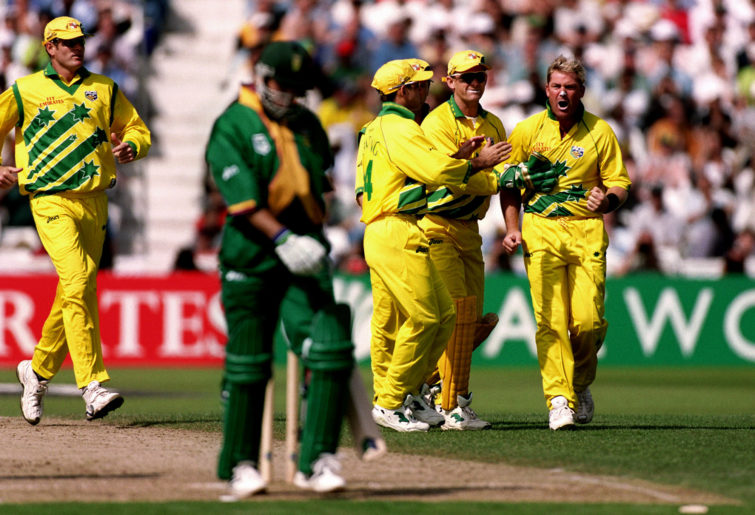
Australia celebrate after Shane Warne dismissed Herschelle Gibbs in the 1999 Cricket World Cup semi-final. (Photo: Michael Steele/Getty Images)
When South Africa looked certain to knock Australia out in the semi-final at Edgbaston, it was Warne who ripped through their top order with a trademark spell of wizardry, including a ball that knocked over Herschelle Gibbs that was arguably as unbelievable as the one that claimed Ball of the Century status in the Test arena against Mike Gatting just six years earlier, also in England.
The Proteas were cruising at 0-48 but then Warne ripped one past Gibbs into his off stump, bowled Gary Kirsten after enticing him to go for a big hit and then dismissed their skipper Hansie Cronje, given out caught at first slip even though the ball hit his toe not his bat but that was also part of Warne’s charm, he was able to convince and cajole umpires into thinking he could do anything.
After Warne retired from international cricket after the SCG Test in 2007 alongside great mates Glenn McGrath and Justin Langer, it triggered a steep decline for the Australian team.
Selectors tried and failed the impossible task of trying to find a spinner who could replace Warne, cycling through several candidates with limited success. They were never going to find another Warne.
Nathan Lyon, known as the GOAT for being Australia’s greatest off spinner with more than 400 Test wickets, finally gave Australia a long-term option but he knows the greatest of all time is the Victorian leggie who is immortalised in a statue outside the MCG.
There will only ever be one Shane Warne.
Rest in peace.



































































































